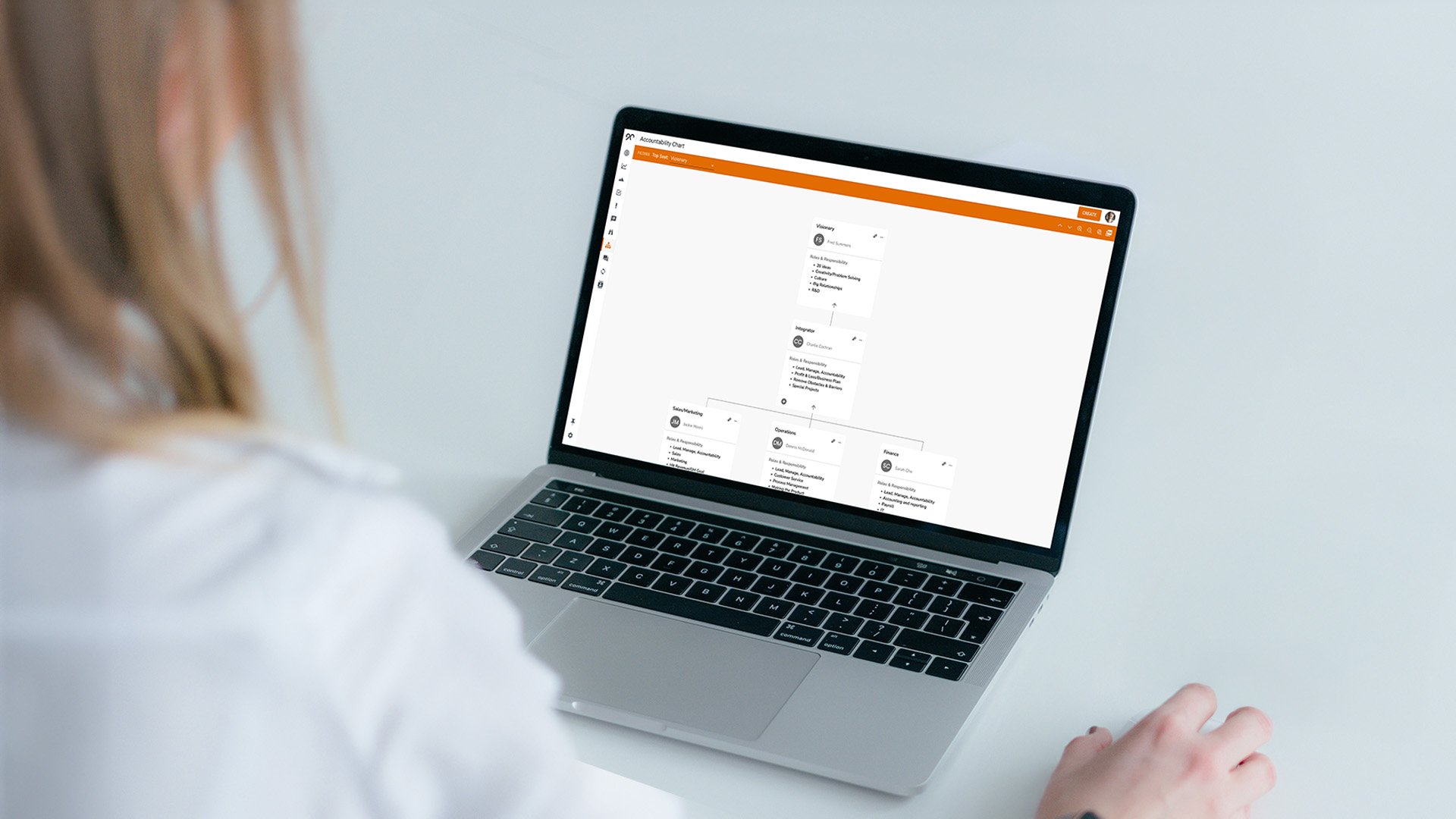The EOS® Accountability Chart: Know Who's Who in Your Zoo
In his book Good to Great, Jim Collins famously said “If we get the right people on the bus, the right people in the right seats, and the wrong people off the bus, then we’ll figure out how to take it someplace great.” This concept took on a life of its own and today we often refer to it as Right People - Right Seats. So how do we know if we have the Right Seats?
Unlike a traditional organizational chart that focuses on job titles or who reports to whom, the Accountability Chart focuses on functions, responsibilities and roles. It clearly defines the seats you need to achieve your vision, the metrics by seat to help get you there and helps leaders know they have the right people in the right seats.
What Is the Accountability Chart and Why Does It Matter?
An EOS Accountability Chart™ is a tool used in the Entrepreneurial Operating System® (EOS) to clarify who is responsible for what in an organization. It goes beyond job titles and departments by focusing on clear roles, responsibilities, and lines of accountability. This helps teams improve clarity, alignment, and decision-making. This is a forever tool updated every quarter and it is shared with everyone in the organization.
Benefits of an EOS Accountability Chart
- Clarifies roles and responsibilities so everyone knows exactly what they’re accountable for.
- Eliminates overlap and confusion that slow down execution or lead to dropped balls.
Creates a future-focused structure based on where the business is going, not who’s already on staff. - Supports better decision-making by defining leadership roles, core functions, and ownership.
- Helps get the right people in the right seats by aligning team members with roles they’re best suited for.
- Reveals gaps or redundancies in your current structure that may be holding you back.
- Improves accountability and performance by making it clear who is responsible for outcomes.
- Aligns your team around a shared vision, making it easier to set goals, delegate, and scale.
This tool is foundational to building what we call “structure first, people second.” We don’t build the chart around current employees or titles. Instead, we define the right structure for where the business is going in the next 6 to 12 months. Only then do we ask, “Do we have the right people in the right seats?”
This is critical because clarity drives accountability. When everyone knows who owns what, things get done faster, with less drama and fewer dropped balls.
How to Build a Functional EOS® Accountability Chart?
Your organization already has a structure today. Our exercise is to give space to re-imagine the organization operating at its best and then what structure do we need to achieve this. Here is an example to help guide your leadership team through the process of creating an effective EOS® Accountability Chart:
1. Start With Sales, Operations, and Finance
The Accountability Chart starts with the fundamental belief that no matter the industry, every organization has to sell something (Sales & Marketing), deliver something (Operations), and track and manage resources (Finance/Admin). These three functional areas are universal, so they provide a solid starting point that’s clear and familiar for any leadership team. Start by creating charts for these three teams:
- Sales & Marketing
- Operations
- Finance/Admin
Define what each function is responsible for, then decide if you need to break those down further into specialized seats like HR, Customer Success, Product, etc. This may be essential for larger or more specialized teams.
2. Establish the Visionary and Integrator Roles
50% of the time organizations have two seats; Visionary and Integrator. The Visionary brings big-picture thinking, innovation, and energy to the organization—they’re often the founder, brimming with ideas and passion for the future. The Integrator™, on the other hand, is the steady hand who drives execution, harmonizes the leadership team, and ensures day-to-day operations align with long-term goals. Together, they form a dynamic duo—the Visionary dreams it, and the Integrator makes it real. This partnership sits at the top of the Accountability Chart because without it, most entrepreneurial companies hit a ceiling they can’t break through.
These two roles sit at the top of the Accountability Chart and form the critical one-two punch in scaling an entrepreneurial business.
3. Define the Seats with five Roles, Responsibilities and Metrics
Once your Accountability Chart™ is in place, it’s time to go deeper. That’s where —Roles, Responsibilities, and Metrics come in. Each seat should have 5 clear bullet points describing what that role is accountable for. This helps eliminate ambiguity and aligns expectations. They provide the next level of clarity: They take the five high-level accountabilities in each seat and break them down into specific outcomes. Not tasks. Not job descriptions. Results. It’s a powerful tool for creating agreements-based leadership.
- What are RRMs?
Roles describe what the person is generally responsible for. Think big buckets (e.g., “Owns Marketing Strategy”). - Responsibilities outline the specific areas they own. These are the five bullets in your Accountability Chart (e.g., “Lead Generation,” “Brand Messaging,” “Website Performance”).
- Metrics are the measurable outcomes we expect. There normally is a quality metric, a quantity metric and often a combination of the two. This is what success looks like (e.g., “Generate 100 MQLs per month” or “Maintain 40% email open rate”).
RRMs help drive performance conversations, strengthen Scorecard alignment, and allow leaders to delegate outcomes, not just tasks—freeing up the leader and empowering the team.
4. Right People, Right Seats Test
Use the People Analyzer™ to evaluate Core Value alignment and whether team members GWC™ their seat (Get it, Want it, have the Capacity to do it). The People Analyzer™ is a simple yet powerful EOS® tool that helps leaders assess team members based on alignment with the company’s Core Values and whether they GWC™ their seat (Get it, Want it, and have the Capacity to do it). It creates a common language for performance and culture fit, making hiring, coaching, and difficult decisions more objective and consistent.
Create a Functional Accountability Chart with Ninety Today
Building your Accountability Chart isn’t a one-time exercise. It’s a living document. Revisit it quarterly, especially during your annual planning and quarterly sessions. It’s your blueprint for building a great organization—one seat at a time.
Ready to build your accountability chart? We believe in it so much that we offer it in the free version of Ninety. Start building your Accountability Chart today!
Existing user? Login here
A traditional org chart focuses on job titles and reporting lines, while an Accountability Chart defines the functions your organization needs and clarifies who is accountable for what. It’s about roles, not hierarchy—accountability over authority.
Review it at least quarterly, especially during your EOS® Quarterly and Annual Planning sessions. Your structure should always reflect the business you're building next, not the one you used to be.
Yes—but only if they GWC™ each seat (Get it, Want it, Capacity to do it). As your company grows, the goal is to eventually have one person per seat for optimal focus and accountability.
Start with the EOS Accountability Chart™, then layer in the People Analyzer™, the Vision/Traction Organizer® (V/TO®), and Scorecard to align people, roles, and outcomes. Using a platform like Ninety helps keep everything centralized and easily accessible.
It provides a clear structure that helps leaders coach their teams based on defined roles and expected results. Tools like RARs (Roles, Accountabilities, Results) and Quarterly Conversations help shift from managing tasks to developing leaders who own outcomes.




